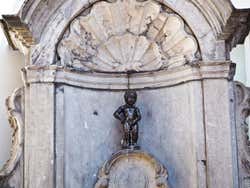
Manneken Pis
With a long and storied history, and dimensions which make it an attraction which can easily pass unnoticed by the majority of tourists, the Manneken Pis has become a symbol of Brussels.
The Manneken Pis was designed in 1388 and is one of the most representative and loved symbols of Brussels, originally serving as the means by which many Bruxellois received water. It is a small bronze statue that measures 50 cm and represents a small naked boy urinating into a fountain’s basin. It is located in the old part of town, between rue de L'Étuve and rue Chene, next to the Grand Place.
Given the importance of the statue, many armed forces have tried to steal it throughout the years, until an ex-convict was finally able to do so in 1817. The statue was broken into 11 pieces, but welded together and has been maintained there to the present day. Thus it has marked on its base both the original date of fabrication and restoration: "1620 - REST 1817".
Legends behind the Manneken Pis
Throughout the years, many legends have surrounded this tiny, surprising statue. These are the most famous:
- The little boy put out a fire with his tinkle, thus saving the city from being burnt down.
- It is also believed that during a battle in Ransbeke, the two-year-old Lord (Duke Godfrey III of Leuven) was hung from a tree in a basket to bring his troops luck while they fought against the enemies and from there he urinated on the enemy troops and they lost the battle.
- According to another legend, the son of a noble abandoned a procession to urinate on the wall of a witch’s house. Angered by his action, the witch transformed him into a statue.
Outfits of the Manneken Pis
In 1698, a governor gave the little statue its first tunic. It was the first of the 1,000 outfits the Manneken Pis owns currently. These costumes have been given by the various presidents that have visited Brussels. In the Musée de la Ville, housed in La Maison du Roi, visitors can discover all the little hero’s wardrobe including regional dresses, a bullfighter or Elvis costume.
The Manneken Pis is regularly dressed up, according to a published shcedule posted on the railings of the fountain and managed by a non-profit organisation: "The Friends of Manneken-Pis".
The symbol of Brussels
The Manneken Pis has become of the most important landmarks in Brussels. Other representative attractions include the Atomium and the Grand Place. We believe that it is definitely worthwhile visiting, as well as taking a photo.
Very close to the Grand Place visitors can also find the Manneken Pis’s “sister”, Jeanneke Pis. A female version of the little boy urinating, which is a lot less famous but also curious to see.

Transport
Metro: Bourse and Gare Centrale, líneas 1 and 5
Tram: Anneessens, lines 3, 4, 31, 32 and 33
Bus: 29, 34, 47, 48, 60, 63, 65, 66, 71, 95 and 96
Nearby places
Grand Place of Brussels (265 m) Museum of the City of Brussels (296 m) Galeries Royales Saint-Hubert (467 m) Jeanneke Pis (485 m) Magritte Museum (679 m)

